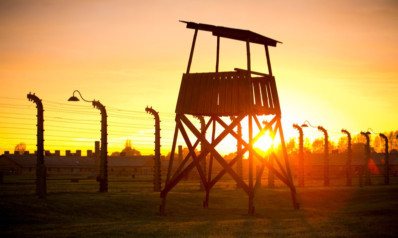The heartfelt wail of the Hebrew prayer rang out into the darkness just yards from the ruins of a crematoria which, more than 70 years ago, was detonated by the fleeing Nazis as they attempted to cover their tracks in the face of the advancing Red Army.
The powerful reading honoured the martyrdom of the estimated six million souls who were murdered, tortured, burned, starved and worked to death at the hands of Nazi oppressors in Auschwitz, Belsec, Bergen-Belsen, Dachau, Majdanek, Sobibor, Treblinka and other extermination camps in Europe.
For the 200 Scottish schoolchildren and their teachers huddled before Rabbi Barry Marcus in the biting cold and waiting to light candles of remembrance,it was a moving finale to a day which explored the Auschwitz-Birkenau death camp’s dark history.
It is easy to be overwhelmed by the figures. In this one camp alone, at least 1.2 million are estimated to have been exterminated including one million Jews, 75,000 Poles, 21,000 Sinti and Roma and 15,000 Soviet Pows.
But how do visitors make sense of the unimaginable?
One way is to personalise the past through the stories of individuals and families.
And that is a key approach by the Holocaust Educational Trust’s (HET) Lessons from Auschwitz Project, which, for 16 years, has brought together senior pupils from schools across the country to visit the extermination camps and pass on lessons about their experiences in their schools and communities when they return home.
It is based on the premise that “hearing is not like seeing”, and this was certainly a day of heavy reflection for the pupils, who were physically and emotionally challenged by the intense day trip experience.
After a very early morning flight from Glasgow to Krakow, and a coach journey through the scenic Polish countryside, the first stop was the Jewish Cemetery in the village of Oswiecim, known in German as Auschwitz, close to the death camps.
Before the war, 58% of the village was Jewish. That equated to 7000 of Poland’s then 3.3 million Jewish population. Now, with just 20,000 Jews estimated to be left in the country, not one lives in Oswiecim.
And yet 15 years after the town’s last Jew died, random anti-Semitic attacks on the cemetery continue.
“It’s interesting you can have anti-Semitism without Jews,”said HET educator Martin Winstone, hosting our group. “It’s depressing”.
Students then visited Auschwitz I to see the former camp’s barracks and crematoria. The contrast of the crisp sunny autumn day, snack bars and coach park on arrival was at odds with starvation blocks, torture chambers and piles of belongings seized by the Nazis displayed inside.
Cabinets were filled to the brim with possessions seized from inmates as they entered children’s shoes, hairbrushes, spectacles, prosthetic legs
One of the most disturbing sights was the room-sized glass cabinet piled high with human hair. It represented the last shreds of dignity shorn from millions of women.
Kelsey Harvey, 16, from Braeview Academy in Dundee said: “I find it crazy people could do this. I’m in total shock. I can’t believe how many people were here 70 years ago, walking to their deaths.”
Samuel Hill, 17, of Forfar Academy said: “I didn’t realise the scale of it until I got here.”
If Auschwitz I is about what you see, then neighbouring Auschwitz II, or Birkenau, is about what you don’t see. Birkenau was the main killing centre – and the immediate impact is its vastness.
Students visited the remnants of once rat-invested barracks, crematoria and gas chambers and heard tales of squalor, cruelty and mass murder.
The site includes the iconic rail spur, built in 1944, where trains loads of men, women and children from across Europe were offloaded and either sent to work as slaves or, more likely, sent straight to the gas chambers.
It was this spot that the testimony of one Romanian survivor, Elie Wiesel, was remembered as he parted from his mother forever. “An SS officergave the order: ‘Men to the left! Women to the right!’ Eight words spoken quietly, indifferently, without emotion. Eight short simple words. Yet that was the moment when I parted from my mother.”
As darkness fell, Rabbi Marcus, the founder of the UK and Scottish Government-backed Lessons from Auschwitz trips, gave a passionate speech during which he said that to remember every one of Auschwitz-Birkenau’s 1.2 million victims would involve the group having to stand in silence for two years.
He said Auschwitz was a warning to the world of what can happen if prejudice and intolerance is left unchallenged. Yet it was also a celebration of life, freedom and human defiance. He denounced the world’s Holocaust deniers.
Reflecting on the day, Carnoustie High School’s Fiona Muirhead, 17, said: “People were treated worse than animals. Facts and figures are one thing, but these were real people.”
Agata Zydel, 16, of Kirkcaldy’s Viewforth High School, said: “Just sitting in a classroom and reading a history book, you have no idea how bad it was.”
On the flight home that night, after an emotionally draining, sleep deprived, yet fulfilling day, it was sobering to think that for the majority of Auschwitz visitors there was no return ticket.
